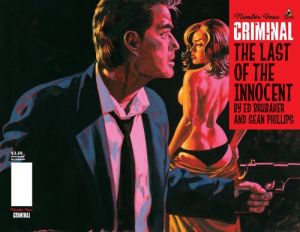Criminal: The Last of the Innocent #4
By Zak Edwards
September 14, 2011 - 16:37
Marvel Icon
Writer(s): Ed Brubaker
Penciller(s): Sean Phillips
Colourist(s): Dave Stewart
$3.99 US
Today marks the end of another volume of Ed Brubaker and Sean Phillips’ Criminal series, a book that should be on everyone’s read list. Brubaker and Phillips’ collaborations throughout the years have almost been exclusively of high quality and The Last of the Innocent continues this pattern forward, to the point where the worst part about this issue is the finality of the series for now. Luckily, Brubaker speaks of plans for the next collaboration in the back of this issue: an “epic noir/horror story” that will occupy the next couple of years, being an estimated twelve issues in length. But rather than look to the Criminal-less immediate future, let’s look at what Phillips and Brubaker has left us with. Bear in mind, owners of small children, that Criminal falls under Marvel Comics’ Icon imprint, which doesn’t follow much in terms of censorship. Being wonderfully pulpy and noir, Criminal has enough sex and profanity to warrant read through before passing such books to the younger comic lovers.
 |
The Last of the Innocent has focused primarily on nostalgia, a somewhat strange yet perfectly fitting topic for Brubaker’s almost trademark fascination and imitation of old time pulp adventures. And while things seem to wrap up far too quickly this issue, a pacing issue I will have to look into by rereading the miniseries, the book balances the dangers of nostalgia with the immediate demands of the present in a fairly unexpected turn. Indeed, protagonist Riley Richards (whose name I'll get into later) gets the closest thing to a happy ending in Criminal yet, almost not befitting of the series' style thus far. In actual fact, Riley’s adamant return to his past in this issue's conclusion, brilliantly captured by Phillips’ shifting styles, comes fairly uncomplicated (but more on this later as well). Certainly Brubaker left enough dangling threads to keep Riley’s security on unsteady foundations, but I was generally surprised by how things turned out. Brubaker's ability to flesh out characters in a genre that usually relies on two-dimensional, expected figures, especially in the character of Riley, continues to astound as well. Certainly the protagonist, as has been repeated by too many characters in the book, is not as smart as he thinks, Riley’s complete lack of moral compass and ability to get away with the murder of at least three people fits perfectly with the character Brubaker has unfolded. Wrestling with his nostalgia, he finally got his Betty after getting rid of his Veronica. Unfortunately, however, and in keeping with the metaphors, both Reggie and Jughead were sacrificed for this.
Brubaker’s playing off of the tropes of Archie Comics, and thus connecting readers with a probable nostalgia of their own, has been the hallmark of The Last of the Innocent. Phillips’ wonderful juxtaposition of Archie inspired art with scenarios and dialogue which counteract the expectations of Archie-brand innocence, has propelled the book and questioned Riley’s infatuation and development before and during the book. Reader’s get a final glimpse of this tactic here, especially with Freakout’s final rememberings of his past. While Jughead had a mother and father and dog, Freakout had a mother and her series of boyfriends that left him to his own devices. Moving along the cracks of society, a place he eventually dies in, Freakout saw everything and, like many drug addicts in fiction, couldn’t handle or articulate his experiences, something that got him into a lot of trouble. But for redheaded Riley Richards (the use of alliterative names obviously deliberate and connecting to an even longer history in comic books), his choice of Veronica, or Felix in this case, ended in him with Betty anyways, mostly out of his desire to return to a simpler time, and with Phillips' art, the whole place looks as simple as he desires while being nowhere near the reality. Whereas Archie’s position between two girls has always been one of hijinks and poor time management, Riley’s has been of sexual frustration, with the countering of innocent art highlighting the awkwardness of the teenage experience. It only makes sense that, after having experienced both and deciding on the one that got away, yet another dangerous flirtation of nostalgia, Riley’s depiction in the final panel is simpler, nostalgic, and without consequence. Of course, the background, depicting urban decay and a couple of homeless men, remains foreboding, dangerous, and full of surprises. This final moment, I feel, perfectly encapsulates Phillips’ wonderful artistic ability, as well as shows off his dual style approach to this series. His usual style, with heavy shadows and lines that harken back to noir cinema while remaining competently modern, is gradually simplified in the characters from the first panel of the final page, to wonderful effect. Brubaker and Phillips’ synergy has been maximized in this series and I look forward to the next project, as well as the next volume of Criminal. I have a feeling Brubaker and Phillips haven’t left Riley and his ‘pure’ Betty to be so happy, and that his need for the city, and perhaps a new form of nostalgia at his former life he purposefully and expertly destroyed, will bring him to a more pulpy demise.
Grade: A Yet another stellar collaboration. A thematically complex and layered exploration of both comics and their readers.
Related Articles:
Criminal Macabre: Final Night—The 30 Days of Night Crossover #1 Preview
Criminal: The Last of the Innocent #4
Dark Horse Collects Niles' "Criminal Macabre" in Two Omnibus Editions
Criminal: The Sinners #5
The Dead And The Dying New Criminal Trade
Bad Night Starts New Criminal Story Arc
Ed Brubaker & Sean Phillips: Criminal Vol. 1: Coward
Criminal Nomination
Criminal #1 - #5
Walking Dead Criminals
